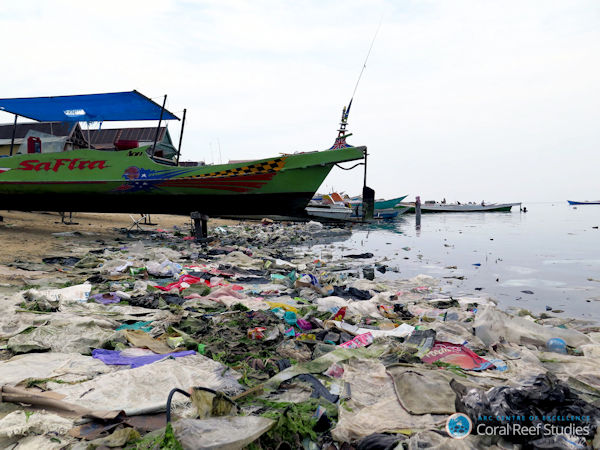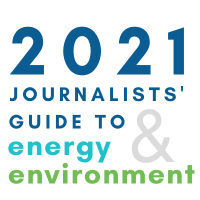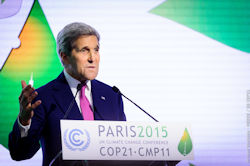SEJournal Online is the digital news magazine of the Society of Environmental Journalists. Learn more about SEJournal Online, including submission, subscription and advertising information.
 |
| The incoming Biden administration will face a wide range of environmental treaty considerations, among them a plan to limit ocean pollution from plastics. Above, plastic debris lining a beach in Sulawesi, Indonesia, in 2014. Photo: ARC CoE for Coral Reef Studies/Joleah Lamb, Flickr Creative Commons. Click to enlarge. |
Issue Backgrounder: Biden Faces Environmental Challenges on Multiple International Treaties
EDITOR'S NOTE: This story is one in a series of special reports from SEJournal that looks ahead to key issues in the coming year. Visit the full “2021 Journalists’ Guide to Energy & Environment” special report for more.
 |
By Joseph A. Davis
As president, Joe Biden will face an array of international negotiations and agreements that matter for the environment.
While the complex and ongoing conversation over the Paris Climate Accord may get immediate priority, environmental journalists may want to track some of the other multilateral environmental treaties, too.
This Issues Backgrounder takes a closer look at 10-plus top treaties to keep an eye on:
Paris Agreement on climate
The treaty negotiated in 2015 was a major accomplishment of the Obama administration. By withdrawing the United States from the treaty, President Donald Trump made the country the only one in the world to quit the pact. Some 189 nations have ratified it and a few more have signed (but not ratified).
 |
| Former U.S. Secretary of State John Kerry at the 2015 U.N. climate summit. Photo: COP Paris, Flickr Creative Commons. Click to enlarge. |
President-elect Biden has vowed to rejoin the pact on his first day in office. That one act won’t change much right away, but it may be a start at restoring U.S. leadership on worldwide climate action.
Biden’s pick of former Secretary of State John Kerry to be his special envoy for climate may help, too. Kerry was one of the key actors in getting consensus on the Paris accord during the Obama years.
The hopes embodied in Paris may have unraveled a bit since 2015. The leadership role abandoned by the United States has been only partially filled by China and the European Union.
Despite Trump’s false assertions, the Paris pact didn’t hurt the United States, because it is entirely voluntary and forces no nation to do anything. That, in fact, is the problem. The work ahead — still — is to give it teeth.
The existing Paris pact allows each nation to volunteer its unique “nationally determined contribution,” or NDC, in terms of greenhouse gas reductions. The pact also declared the parties’ collective goal of limiting global warming to “well below” 2° C during this century, preferably 1.5° C.
A 2018 report (may require subscription) by the Intergovernmental Panel on Climate Change, or IPCC, the science body that advises the United Nations on climate, painted dire consequences if the 1.5° goal is not reached. More recent studies suggest that many nations are not meeting their NDC commitments and that the world could warm 1.5° C by 2025.
As Biden re-engages the United States in the Paris process, there are some touchstones to watch.
First, to use U.N. lingo, is “ambition.” That means convincing signatory nations to jack up their NDC commitments to a higher level, hopefully one that will keep the temperature goals from being exceeded.
Second is “transparency” — which means each nation showing its receipts to prove that it is fulfilling its NDC pledge. The issue, with nations like China, is, “How do we know you are doing what you say you are doing?”
Another code phrase you need to know is “loss and damage.” The idea is that the emissions of rich countries like the United States are hurting poor, underdeveloped and vulnerable countries, like small island nations that may be completely swamped by sea level rise.
Poorer countries have asserted that rich countries
owe them compensation. ... This is a chronic conflict
that has beset climate talks from the beginning.
Many of the poorer countries have asserted that rich countries owe them compensation — money — not only for fairness, but to help them comply with low-emission goals and adapt to climate damage.
This is a chronic conflict that has beset climate talks from the beginning. When rich nations have promised financial help, they have often fallen short of promises. When Trump dropped out of Paris, he also declared that the United States would not follow through (may require subscription) on what it had pledged to contribute to the Green Climate Fund, one of the mechanisms for transferring such aid.
The nations that pursue the Paris accord meet in full regalia every year in what is called a “Conference of Parties,” or COP. It’s the biggest of many meetings. COP26, which was supposed to happen in November 2020 in Glasgow, was postponed because of the pandemic. It is currently slated for Nov. 2021. The international jockeying has, however, continued from afar, driven partly by world events like the pandemic and fossil fuel markets.
One does not have to be a clairvoyant to know that John Kerry has his work cut out for him.
Convention on Biological Diversity
Another big one is the U.N. Convention on Biological Diversity, or CBD, which was started back in 1992 at the Earth Summit in Rio. Over the years, some 196 nations have ratified it. But not the United States.
The CBD is really the keystone of an array of other international treaties related to biodiversity (see more below on the Convention on International Trade in Endangered Species, or CITES, which restricts trade in endangered species). The next COP for this treaty, because of the pandemic, was postponed from October 2020 to May 2021 in Kunming, China.
That will put it squarely on Biden’s international “to-do” list.
Even though it has not ratified the Convention
on Biological Diversity, the United States could
be a 900-pound gorilla in the discussions.
Even though it has not ratified the CBD, the United States could be a 900-pound gorilla in the discussions. Currently, Brazil is at odds with other nations — technically over meeting formats, but really over President Jair Bolsonaro’s policies on the Amazon rainforest.
The departure of Trump, a Bolsonaro cheerleader, could alter the dynamics of the CBD meeting, which is intended to set a framework for the treaty’s future.
Marine Fuel Agreement
Most issues related to ocean shipping are regulated (to the extent they are regulated) by agreements adopted under the International Maritime Organization, or IMO. Back in 1973, many of the IMO nations agreed to a treaty called MARPOL, intended to cut down on marine pollution.
The latest version, MARPOL 2020, calls on nations to set standards for lowering sulfur in marine fuel. Historically, ship engines have used “bunker fuel,” similar to diesel but often with high sulfur content, which means a lot of soot.
The U.S. Environmental Protection Agency participates in setting standards under MARPOL for U.S. waters. Since the standards are supposed to have come into effect this year, the incoming Biden administration may face a challenge in enforcing them.
Airplane emissions
It was big news in 2016, the first year after the Paris accord, when some 191 nations, meeting under U.N. auspices, agreed that they should do something to reduce greenhouse gas emissions from non-military aircraft. That may have been the high point.
The deal seemingly struck by the International Civil Aviation Organization, a U.N. entity, aspired to remove some 10,000 million tonnes of greenhouse gases from the atmosphere each year. Things even progressed to the point of the EPA proposing a rule that would have set emission standards for certain airplane engines.
But the COVID-19 pandemic had other plans. By the middle of 2020, the airline industry was facing huge losses as passengers disappeared out of virus fear. Suddenly, all Congress and the administration could think about was how to legislate tens of billions of dollars to rescue the industry from total oblivion.
Tune in again when the pandemic is over.
The Arctic Council
The Arctic Council isn’t a treaty exactly, but a serious international forum about a set of issues growing more important all the time. And the United States has a seat on it. It was set up by the Ottawa Declaration of 1996. The incoming Biden administration faces important issues in the Arctic.
The Arctic matters because it is the part
of the globe most severely and quickly
affected by climate change.
The Arctic matters because it is the part of the globe most severely and quickly affected by climate change. It is melting, or at least thawing. This affects life and culture in the Arctic itself — and the rest of the globe too. The waning of ice is opening not only new global sea lanes, but potentially many oil and gas development projects, too.
Nations on the Council beside the United States are Canada, Denmark, Finland, Iceland, Norway, Russia and Sweden. Six organizations representing Indigenous cultures are permanent participants.
The United States held the rotating chairmanship of the council during 2015-2017. Russia will chair the council for 2021-2023. The council will be one arena where U.S.-Russian relations will evolve during the Biden era.
If only by virtue of having more icebreakers, Russia is poised to dominate Arctic shipping. Its ability to pursue its oil and gas agenda depends partly on U.S. sanctions, which block funding.
Plastics pollution treaty
Many people have complained for years about the environmental harm caused by plastics, especially those which end up polluting the ocean.
Now there is a global movement to do something about it. The question is whether the United States is on board.
Preliminary meetings have been promising, with some two-thirds of nations indicating they are open to the idea of a new international agreement to limit plastics. A working group set the stage when it met in November 2020.
The main event, however, will come at the big biennial meeting of the U.N. Environment Assembly (the plenary of the U.N. Environment Programme) on Feb. 22-26, 2021. It is slated to be in Nairobi, Kenya, where UNEP has its headquarters, although the pandemic may make it virtual.
So far, though, the United States and the United Kingdom, two of the biggest waste-producing nations, have not endorsed a global treaty to limit plastics in the ocean. U.S. environmental groups hope Biden will jump in and support the international effort. In fact, they have asked for much steeper restrictions on plastic, including its manufacture.
Montreal Protocol on HFCs
The Montreal Protocol, reached in 1987, regulates substances that deplete the stratospheric ozone layer — which protects the Earth from harmful ultraviolet radiation. By most accounts, it has been a fairly successful treaty.
One outstanding issue is a new class of chemical, hydrofluorocarbons, or HFCs, which came into use to replace ozone-depleting chlorofluorocarbons. CFCs have the harmful side effect of warming the climate (they are greenhouse gases). In October 2016, the 196 nations who are party to the Montreal Protocol agreed on a measure to phase out HFCs. It was called the Kigali Amendment.
The Kigali Amendment was developed under U.S. leadership during the Obama administration. It entered into force in 2019, when the requisite number of nations ratified it. Under the Trump administration, however, it has remained unratified.
That puts it on a potential environmental international to-do list for Biden (or really for Kerry, whose baby it is). Senate action would be needed for the United States to ratify the Kigali Amendment. At least a dozen GOP senators and the U.S. Chamber of Commerce have endorsed it. The problem, it seems, was the Trump administration, which was opposed to action on climate change and multilateralism generally.
Other treaties
There are a lot more international environmental agreements than most people realize — some 3,000 by one count. Those mentioned above are only the handful that may cause President Biden real political heartburn in the near term.
For example, the Convention on International Trade in Endangered Species, or CITES, originated in 1963 and is a fairly stable treaty. There is a full meeting every two or three years, but the United States does not seem embroiled in major CITES issues right now. CITES is an offshoot of the International Union for the Conservation of Nature, or IUCN, which makes news every year when it updates its “Red List” of endangered species.
The Migratory Bird Treaty Act, which
Congress first passed back in 1918, gets
updated a lot and argued about even more.
Another is the web of international agreements that the United States implements via the Migratory Bird Treaty Act, which Congress first passed back in 1918. This gets updated a lot and argued about even more. Most recently, the uproar has been over the Trump administration’s reinterpretation of the MBTA to allow killing of birds by companies when the killing is not intended (e.g., an oil spill).
Another issue, hard to find in mainstream media headlines, has to do with cross-border transfer of waste, particularly hazardous waste and electronic waste. There does exist a fabric of international treaty law, under the Basel Convention, for example, aimed at controlling these waste flows.
But children still scavenge through toxic e-waste in dumps in Ghana and other developing countries. One of the few international bodies trying to address the problems is the World Health Organization, from which Trump this year withdrew the United States.
Joseph A. Davis is a freelance writer/editor in Washington, D.C. who has been writing about the environment since 1976. He writes SEJournal Online's TipSheet, Reporter's Toolbox and Issue Backgrounder, as well as compiling SEJ's weekday news headlines service EJToday. Davis also directs SEJ's Freedom of Information Project and writes the WatchDog opinion column and WatchDog Alert.
* From the weekly news magazine SEJournal Online, Vol. 5, No. 46. Content from each new issue of SEJournal Online is available to the public via the SEJournal Online main page. Subscribe to the e-newsletter here. And see past issues of the SEJournal archived here.













 Advertisement
Advertisement 




